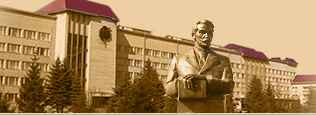PODZOLIC CHERNOZEMS (FAEOZEMS) OF LVIV REGION IN THE SYSTEM OF SOIL-GEOGRAPHICAL REGIONALIZATION: GEOGRAPHY AND REGIONAL PECULIARITIES.
The available soil-cartographic and printed materials show us the presence of Podzolic Chernozems (Faeozems) in the structure of the soil cover in Lviv region as typical zonal components. This fact cannot be considered to be completely true. The main aim of research is to reveal the true nature of the spatial mosaic of Podzolic Chernozems, their place in the landscape structure of the region. The basis of these researches are large-scale soil maps (scale 1:10 000 and 1: 5 000) of collective farms of the Lviv region, advanced schemes of geomorphological and physic-geographical zonation of Ukraine, and materials of field and laboratory researches of the Lviv region chernozems. At the base comparative-geographical method within of the Lviv region (Pidpodilskyi natural area, Sokal-Torchynska and Syansko-Dnisterska hills, Pasmove Pobuzhya and Opillya) were selected representative of key areas. Within each of them, in the way deep trenching and soil-environmental profiles, using historical-evolutionary and genetic-morphological methods, have researched formation of the soil cover structure and modern geochemical contiguity of chernozems with other soils. In order to identify quantitative parameters of regional differences of Podzolic Chernozems are used complex laboratory standard methods. The spatial mosaic of Podzolic Chernozems of Lviv region has a definite regional lithological and hydrological restriction. They are the important component of soil cover found into all nature areas of Lviv region besides the Carpathian and Pre-Carpathian regions. These soils have been formed on well aerated loess plains. Podzolic Chernozems are not zonal soils in Lviv region. They hold transitional positions among zonal forest soils. These Chernozems genetically belong to a group of ordinary, regradated and hydrogen-transformed Podzolic Chernozems. Podzolic Cernozems of the Volyn hill are mostly medium-regradated, shallow and medium profound (53-66 cm). They have a lumpy structure and the bedding line of calcium carbonate is closer to the surface (50-100 cm) with rapid boiling. There are mole drains within the transitional humus horizon. Also, there is relatively high occurrence of segregational carbonate neoformations with the humic transition horizon of clearly tongue form in the soil profile. Morever, these soils do not have a clear-accumulative carbonate horizon. Chernozems of the Range Pobuzhya, as the Pod-Podolian nature region, are mainly medium profound, gleyey, shallow-regradated without the accumulative carbonate horizon. Chernozems of the Nearpodolian region are profound and medium profound, mycelial-calcareous, not gleyey or profound-gleyey. Also, they have a strong grain structure, mainly carbonate. Podzolic Chernozems of Opillia are main ordinary of kind.
Key words: Podzolic Chernozems, humus horizon, morphological construction of profile, gleyzation, regredated soils.
References:
- Andryushchenko, G. A., Bilskaya, M. V., Bilan, A. M., Voronoy, V. V., Sukharskaya, I. M. (1981), “Chernozemy lesostepnoy zony Vlazhnoy atlanticheskoy fatsii” [“Chernozems of forest-stepper zone of the Humid Atlantic facies”] Chernozemy SSSR (Ukraina) [Chernozems of the USSR (Ukraine)], Moscow: Kolos, pp. 80–95.
- Hulyk, S. V. (2005), Kadastrovi karty yak dzherelo vyvchennya stanu zemelnykh resursiv Halychyny XVIIІ – poch. XX st. [Cadastral maps as a source of study of the state of land resources of Galicia XVIIІ – beg. XX century], History of Ukrainian geography, vol. 11, pp. 85–88.
- Olenchuk, Ya., Nykolyn, A. (1969), Grunty Lvivskoi oblasti [Soils of Lvov region], Lvov: Kamenyar, 84 p.
- Papish, I. Ya., Poznyak, S. P. (2010), Problemy genezy chornozemiv Halychyny [Problems genesis of Galician’s chernozems], Bulletin of the Lvov University, Serious Geography, vol. 38, pp. 271–280.
- Papish, I. Ya., Poznyak, S. P., Pankiv, Z. P., Yamelynets, T. S. (2011), Pryntsypy ta kryterii gruntovo-heohraphichnoho raionuvannya Zakhidnoho rehionu Ukrainy [The principles and criteria for soil-geographical zoning of the Western Ukraine], Agrochemistry and Soil Science], vol. 75, pp. 69–74.
- Papish, I. Ya. (2013), Valovyi khimichnyi sklad chornozemiv Sokalsko-Torchynskoi vysochyny [Gross chemical composition of Chernozems of the Sokal-Torchin Upland], Bulletin of the Lvov University, Serious Geography, vol. 44, pp. 265–274.
- Marynych, O. M., Parkhomenko, H. O., Petrenko, O. M., Shyshchenko, P. H. (2003), Udoskonalena schema fizyko-heohraphichnoho raionuvannya Ukrainy [Improved scheme of the physic-geographical zoning of Ukraine], Ukrainian Geographical Journal, No. 1, pp. 16–20.
- Buber, L. (1910), Die galizisch-podolische Schwarzerde, ihre Entstehung und naturliche Beschaffenheit und die gegenwartigen landwirtschaftichen Betriebsverhaltnisse des Nordostens dieser Bodenzone Galiciziens / Leopold Buber, Berlin, 205 S.
